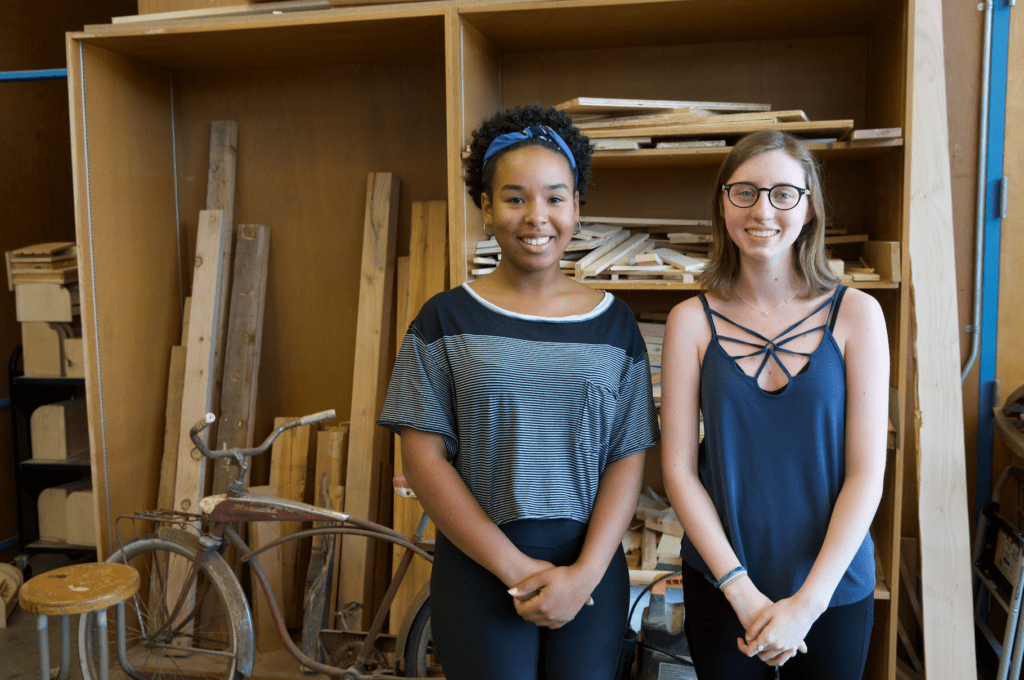TRADART Foundation and Tiny House Initiative
Santa Barbara has no shortage of artisans—one can find a locally crafted version of just about anything here it seems, and that’s not a bad thing. However, somewhere between the homespun and the bespoke, trades as a livelihood seem to have lost a bit of their appeal, at least in the futures of our younger generations.
Or have they?
“We’re learning skills, we’re giving back to the community, and it’s enjoyable. Somebody is going to use this house, and that’s something we’ll know for the rest of our lives.” Zen Yossem-Guy, a 15-year-old sophomore, was standing inside of the tiny house currently under construction at San Marcos High School. The house is part of the Career Technical Education (CTE) initiative, mobilized by the local non-profit, TRADART Foundation.
TRADART’s effort of a renewed focus on the industrial arts (be it woodworking, metalworking, or beyond) is bringing younger generations back to this understanding that these trades aren’t simply an achievement, but a competence that can serve them later in life, with a much larger purpose.
In a way, TRADART holds true to what schools and perhaps kids themselves were once more focused on— practical skills for practical living. Baking, sewing, building— the sort of things that were simply taught and learned, not as a hobby, but as a skill to utilize.
When asked about the alleged laziness of millennials and her forthcoming generation, Zen thought for a moment and replied carefully, “I’d agree, but it’s not that we’re lazy or that we don’t want to learn, it’s that we’re just not being taught…it’s not having the opportunity to learn it.”
A group of Santa Barbara tradespeople banded together at TRADART Foundation and vowed to do something to change this. In their initial Tools For Schools program, the ad hoc group rallied the community (during very meagerly funded years at that), calling upon the Santa Barbara School District, as well as related industries. TRADART invited them to join their call to provide ample wherewithal to fund basic supplies, materials, and support to simply keep the high school woodshops open.
Thanks to a $50,000 grant from the Women’s Fund of Santa Barbara, TRADART has launched their tiny house initiative, in which each high school’s wood shop class takes on the project of constructing, from absolute start to finish, a fully outfitted tiny home. Together, the students are consistent with the houses all the way through, completing everything from framing to wiring to roofing. At the end of construction, each high school auctions off the finished home, and the proceeds fund next year’s class in their building endeavors.
The programs are significant in many ways for the forthcoming generations. By gearing the teaching towards the practical, an emphasis is placed on showing students viable avenues of work from the very skills they are practicing in class— but it’s more than that. A house is a universal symbol of shelter, of structure, of community. People used to come together to raise barns, raise homes, to build one another up. This significance is not lost on the students working on these projects.
Liana Mueller, a 16-year-old junior in the same class as Zen, chimed in, “I noticed a lot of community—in our groups, it’s about finding people who can teach you something, and maybe you can teach them as well. It’s about finding different strengths and coming together, which I think is useful in daily life as well, finding everyone’s strength.”
Beyond this innate sense of togetherness, the students grow on a personal level, beyond just a student, but as a self-sufficient individual. “It’s…comforting. While you’re doing it, you can forget about other things, and just focus on what you’re doing, right here, right now. It’s tangible success, basically. It’s a way to take control of another part of your life. If I can do this on my own, then I don’t have to rely on someone else to do it,” Liana shared, smiling shyly.
Zen joined in, “I get a lot of pride from presenting something or finishing something that I’ve made with my own hands…the feeling of, ‘I did this.’ I can really take charge and ownership of what I’ve made, and am able to say, look at what I made with my own two hands.”

Speaking to the students involved, it’s clear that these classes are unique among their usual curriculum. They contain elements of challenge, of teamwork—of a safe place to experiment and achieve together. They are encouraged to integrate their new knowledge across other disciplines of interest. There are internships and jobs, and for these students, those doors have been opened. By connecting students to their hands, TRADART has connected them back to themselves, to their community.
What is perhaps most impressive about all of this is the realization that these young students have gone beyond just the skills themselves, and are able to recognize that there can be sentiment within utility.
As Zen put it, “Being able to make things for people that they can actually use is so meaningful. Coming back to the houses, I think it’s really important that kids are able to participate in fundraising events with their schools, and this is a fun way to do it, and a really creative way. We’re learning skills, we’re giving back to the community, and it’s enjoyable…we put the energy and time into a house that somebody can live in. That’s a big project.”
For interested parties, the tiny houses’ progress can be viewed at the following locations:
- Dos Pueblos High School
7266 Alameda Ave, Goleta, CA 93117 - San Marcos High School
4750 Hollister Ave, Santa Barbara, CA 93110 - Santa Barbara High School
700 E Anapamu St, Santa Barbara, CA 93103
More information on the houses and TRADART’s work within the community can be found on the foundation’s website at www.tradartfoundation.org.